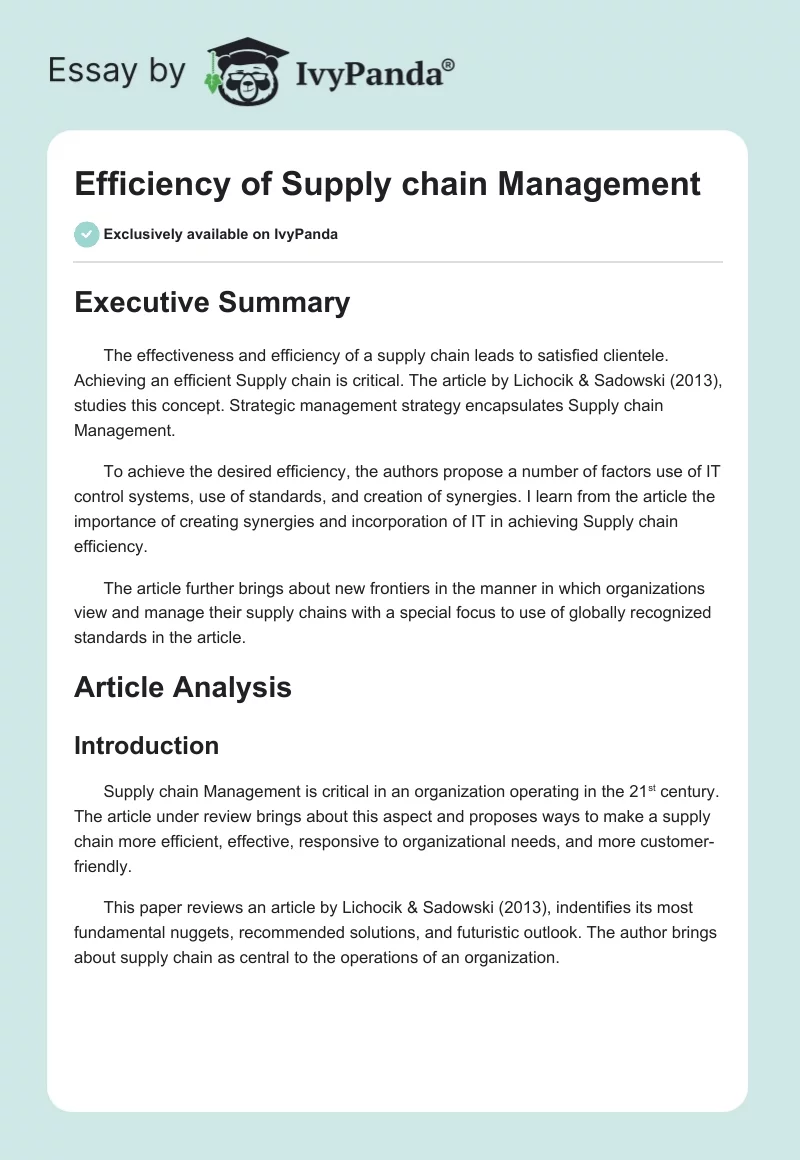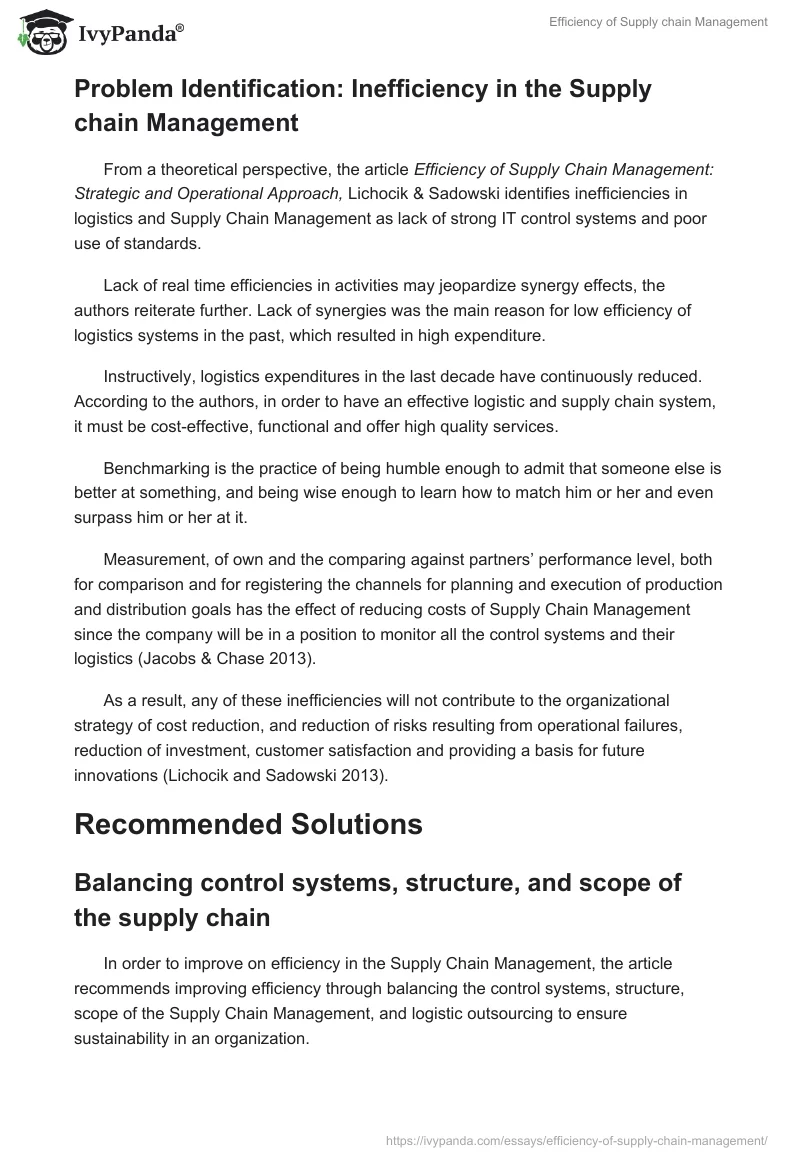Executive Summary
The effectiveness and efficiency of a supply chain leads to satisfied clientele. Achieving an efficient Supply chain is critical. The article by Lichocik & Sadowski (2013), studies this concept. Strategic management strategy encapsulates Supply chain Management.
To achieve the desired efficiency, the authors propose a number of factors use of IT control systems, use of standards, and creation of synergies. I learn from the article the importance of creating synergies and incorporation of IT in achieving Supply chain efficiency.
The article further brings about new frontiers in the manner in which organizations view and manage their supply chains with a special focus to use of globally recognized standards in the article.
Article Analysis
Introduction
Supply chain Management is critical in an organization operating in the 21st century. The article under review brings about this aspect and proposes ways to make a supply chain more efficient, effective, responsive to organizational needs, and more customer-friendly.
This paper reviews an article by Lichocik & Sadowski (2013), indentifies its most fundamental nuggets, recommended solutions, and futuristic outlook. The author brings about supply chain as central to the operations of an organization.
Problem Identification: Inefficiency in the Supply chain Management
From a theoretical perspective, the article Efficiency of Supply Chain Management: Strategic and Operational Approach, Lichocik & Sadowski identifies inefficiencies in logistics and Supply Chain Management as lack of strong IT control systems and poor use of standards.
Lack of real time efficiencies in activities may jeopardize synergy effects, the authors reiterate further. Lack of synergies was the main reason for low efficiency of logistics systems in the past, which resulted in high expenditure.
Instructively, logistics expenditures in the last decade have continuously reduced. According to the authors, in order to have an effective logistic and supply chain system, it must be cost-effective, functional and offer high quality services.
Benchmarking is the practice of being humble enough to admit that someone else is better at something, and being wise enough to learn how to match him or her and even surpass him or her at it.
Measurement, of own and the comparing against partners’ performance level, both for comparison and for registering the channels for planning and execution of production and distribution goals has the effect of reducing costs of Supply Chain Management since the company will be in a position to monitor all the control systems and their logistics (Jacobs & Chase 2013).
As a result, any of these inefficiencies will not contribute to the organizational strategy of cost reduction, and reduction of risks resulting from operational failures, reduction of investment, customer satisfaction and providing a basis for future innovations (Lichocik and Sadowski 2013).
Recommended Solutions
Balancing control systems, structure, and scope of the supply chain
In order to improve on efficiency in the Supply Chain Management, the article recommends improving efficiency through balancing the control systems, structure, scope of the Supply Chain Management, and logistic outsourcing to ensure sustainability in an organization.
Reflectively, these techniques and tools are essential in the art of efficient Supply Chain Management.
Balancing the control systems is inclusive of scientific aspects of operations management such as a technical process of understanding the supply chain operations and proper use of statistical tools, their application, and evaluation criteria in monitoring and managing the logistics behind the supply chain in an organization.
When the above regulator is properly balanced, efficiency in the Supply Chain Management is achievable.
Structure scope of Supply Chain Management refers to the depth of the integration of Supply Chain Management in the various managerial functions. The organization has to achieve a proper balance of this integration.
Through a competitive process, the article suggests that the outsourced unit will develop a balanced control system for a sustainable level of efficiency, costing, dependability, speed, quality, and flexibility through value delivery, value addition, and creativity (Lichocik and Sadowski 2013).
The outsource logistics team will have the responsibility to rationalize the scientific aspects of the supply chain such as the use of statistical tools, their application, and evaluation criteria in monitoring and managing the logistics.
When the outsourced logistics regulator is properly balanced, efficiency in the Supply Chain Management is achievable (Lichocik and Sadowski 2013).
In order to improve on efficiency in the Supply Chain Management, the article recommends improving efficiency through balancing the control systems, structure, and scope of the Supply Chain Management to ensure sustainability in an organization.
In order to achieve a sustainable level of efficiency, the aspect of cost, dependability, speed, quality, and flexibility are incorporated through value delivery, value addition, and creativity (Lichocik and Sadowski 2013). Reflectively, these techniques and tools are essential in the art of efficient Supply Chain Management.
OM Techniques and Operations
An organization should constantly review the management of its supply chain to indentify weaknesses and make proper improvements. One method that the organization may use is standardizing which refers to a strategic organizational comparison.
The comparison encapsulates areas such as productivity, inventory accuracy, shipping accuracy, storage density, and bin-to-bin time.
The aim is to measure any need for improvements and to match the best practices in the area of logistics and supply chain. Comparisons also aids in indentifying emerging trends in the field (Schwalbe, 2012).
What are the takeaways from the article?
The article is rich in critical aspects in supply chain. The article makes it clear that supply chain is a critical aspect of any 21st century organization. It also brings to the fore the importance of use of standards as a tool of measuring organizational success.
Inefficient operations lead to inoperable supply chains. The ramifications may spread to the customer quite fast and are catastrophic to business.
The one thing I learned from the article is determining the best method to indentify inefficiency in logistics and supply chain operations. These include control operations and constant reviews of the supply chain (Schwalbe, 2012).
What are the limitations of the technique?
The article is too analytical and does not explicitly bring about examples to exemplify the inputs. Hence, it appears to be theoretical and not alive to the facts on the ground.
Hence, the technique that the article constantly lauds can also be devoid of the examples from the world leaders in that field.
Conclusion
The article critics, indentifies, and reviews Supply Chain Management using various aspects. Further, the article through evidential explanations lays out strategies that may cure an inefficient supply chain.
These include proper control system, accurate use of industry standards, and use of statistic tools to minimize errors in the system modeling.
To improve the supply chain the article proposes strategies such as constant reviews and a keen eye for emerging trends. Further, the article defines Supply Chain Management to help organizations and scholars.
Sally Beauty Supply Chain Management Case
Internet and globalization are crucial to a current business. Sally Beauty Supply Inc’s store presence goes hand in hand with its online presence. This drives its flexible business model of fitting the right fashion to the right people at the right time affordably.
Sally Beauty Supply Inc. introduced 17 new online markets in 2021. The year 2013 is already promising to be successful. Inditex, Sally Beauty Supply Inc’s parent company, introduced e shopping to 18 new countries in Europe alongside United States and Japan.
With store sales remaining relatively unchanged at an average of 25% across all major markets, online presence has experienced tremendous growth. However, connectivity has brought a major lifestyle revolution the world over.
Hence, Sally Beauty Supply Inc. is even more cautious on trends in regional and global markets. This shows that the overall industry needs to be aware of the benefits that technology brings in line with the continued uptake in many countries.
It is a new route for more revenue generation, trend evaluation and growth (Lichocik & Sadowski, 2013).
References
Jacobs, R. & Chase, B. (2013). Operations and supply management: The core. New York, NY: McGraw-Hill Higher Education
Lichocik, G. & Sadowski, A. (2013). Efficiency of Supply Chain Management: Strategic and operational approach. Log Forum, 9(2), 119-125.
Schwalbe, K. (2012). An introduction to project management. Minneapolis: Kathy Schwalbe LLC.


